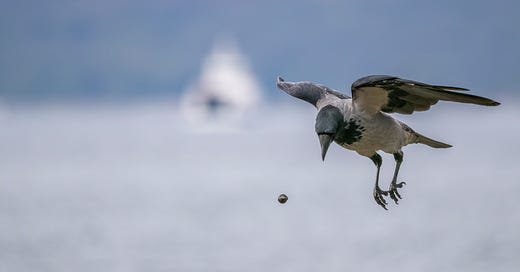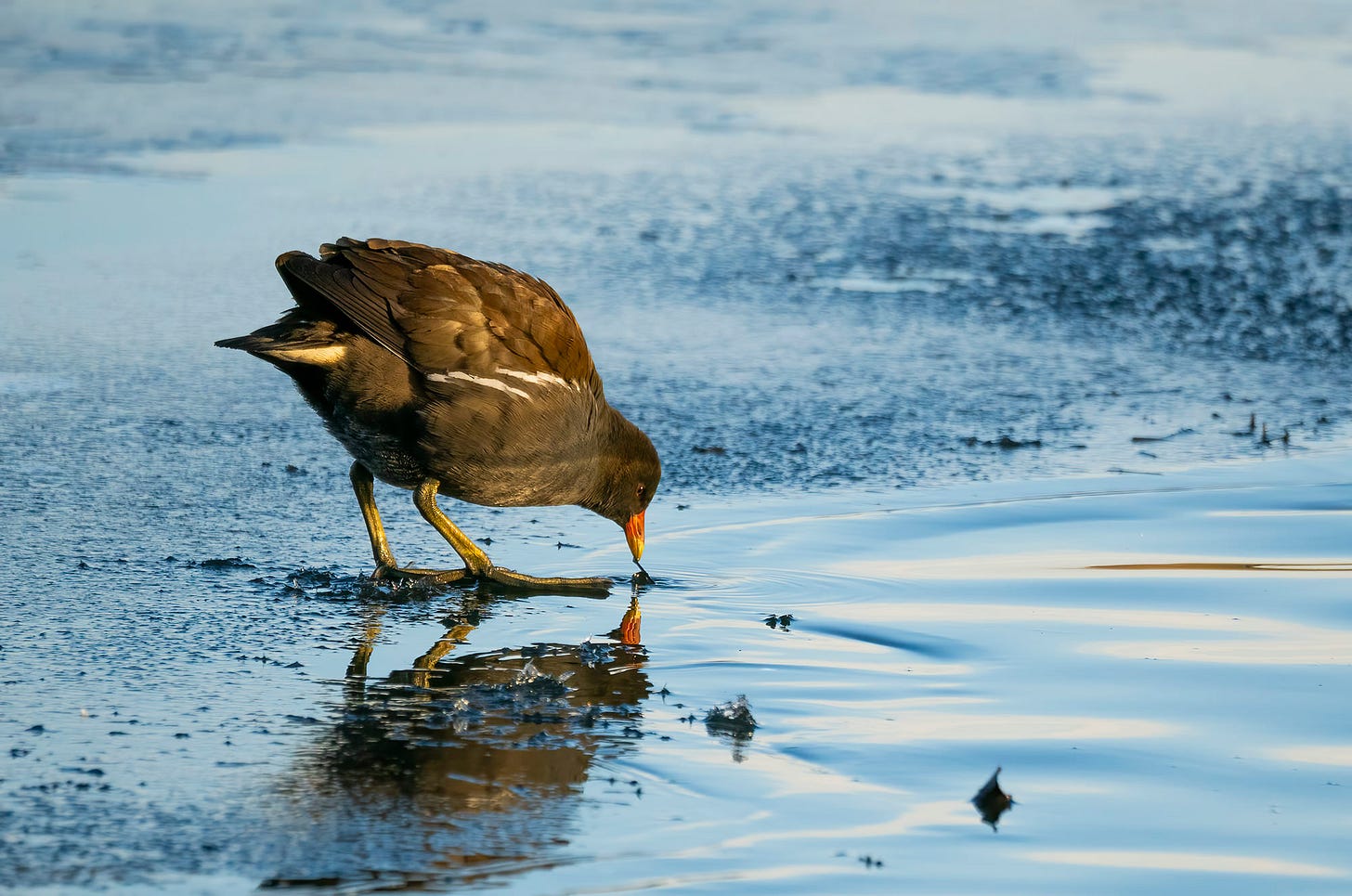October 2024 Viewfinder
Opportunities are missed and taken in this month's Opposite View Wildlife Photography newsletter.
October can be the natural time to slow down and reflect on the changing seasons.
And that’s exactly what I did this month, although somewhat reluctantly. While the leaves began to fall and the clocks prepared to fall back, I was falling ill with COVID-19. I am fully recovered now, thank goodness, but the virus completely wiped me out for nearly two weeks. Even when the main symptoms had faded, the lack of energy remained. It was the strangest feeling to spend each day on the sofa without even missing being outdoors. I guess my body was forcing me to slow down to feel better. But having no desire for fresh air for over a week was an unnerving experience.
Another unusual experience was receiving an invitation to appear on Scotland Tonight. While I took a COVID-induced afternoon nap, a message arrived in my inbox asking if I’d like to come on the programme to discuss the winners of the Wildlife Photographer of the Year awards and show some of my images. I could have wept when I read it after waking up hours later. But as lovely and flattering an opportunity it was, there was no way I was well enough to take it up. There was a reason I was off sick from my day job. Believe me when I say no one would have wanted to look at my pasty face while I spluttered through my thoughts on the WPOTY winners.
There’s a saying in Scotland that “whits fur ye’ll no go by ye” (what’s for you, won’t go by you), and that was of some consolation. Hopefully, there’ll be other opportunities to share my passion for wildlife photography with a big audience…and not when I’m drenched in sweat and constantly coughing.
So, as I’m sure you’ll appreciate, this month has been a quiet one for my wildlife photography. After my COVID slowdown, the wind picked up and Storm Ashley battered Scotland. So, that was another weekend where I didn’t head outside much. But while I’ve had fewer wildlife encounters to write home (or to you) about this month, that doesn’t mean I haven’t thought about my wildlife photography. The announcement of the Wildlife Photographer of the Year and the WildPhotos conference gave me plenty to ponder while I put my feet up.
I’ve blogged about my main takeaways from WildPhotos (see below) but I also want to highlight the work of keynote speaker Charlie Hamilton James and his project to reimagine conservation storytelling - End Times. If you’re not following Charlie on here, I recommend you remedy that right now (well, after you’ve read this). Few others are as refreshingly (sometimes brutally) honest but also warm and inspiring.
Charlie’s presentation closed the WildPhotos conference and I couldn't think of a more appropriate finale. After a day of looking at ‘traditional’ - although powerful - conservation photography, the presentation of End Times and its recasting of the conservation narrative through a darker lens felt like a shock to the system in a good way. Charlie described it as “the shedding of hope because hope didn’t work”. I encourage you to look at the project images and watch the related videos to understand Charlie’s creative process. It’s an opportunity to see conservation photography from a completely new perspective.
And what was my favourite image from WPOTY? Well, I’m going to be completely honest and say that I have a few favourites but I particularly enjoyed Samual Stone’s photo of a jackdaw carrying stones to its nest. On the face of it, a simple image of a common bird but one that cleverly shows the intelligence of corvids. I mean, how perfectly organised are those stones in its beak?! Plus, I’m always delighted when a corvid features in WPOTY.
I’ll leave you with one of my recent clever crow images from the Lochranza shore on the Isle of Arran. This hooded crow was dropping its dinner on a particular rock to break it open. It was exciting for me to get the chance to photograph a corvid species that I rarely get to see, living where I do. I was glad that this opportunity didn’t go by me.
Best wishes,
Rhiannon
Opposite View Wildlife Photography
Through my lens
From emotion to motion - conservation photography in a changing world
In 2011, 2012, and 2013, I attended an in-person conference at the Royal Geographical Society in London called WildPhotos. It was two days where I could completely immerse myself in learning more about nature photography.
These were weekends full of inspirational talks and impressive images from hugely successful and creative photographers from all over the world – many of whom had received recognition at the Wildlife Photographer of the Year Awards. I felt gutted when they pulled the plug on WildPhotos, as it gave me an excuse to geek out on nothing but wildlife photography for two days straight every year.
So, I’m sure you can understand my delight when WildPhotos returned to celebrate the 60th anniversary of Wildlife Photographer of the Year. This time, the event was a one-day symposium held in Bristol and online on Sunday 13th October. And, as with the previous conferences, it provided me with much to consider about my own photography and the stories I want to tell.
In this blog, I share my main takeaways from WildPhotos 2024 and how these could be incorporated into your wildlife photography.
Species spotlight
Moorhen - the master of the marsh
If you live in the UK and head to your local pond, urban lake, or nearest river, you’ll stand a good chance of seeing a moorhen. But then you’ll also stand a good chance of seeing one in parts of Asia, Africa, America, and all over Europe. In some places they are known as the ‘water hen’, in others the ‘reed hen’ – both names that reflect the habitats where this species is most likely to be found.
However, when you stand next to your local loch and watch the coots scrapping with the swans, ducks and gulls for bits of bread and seed, the moorhen will most likely stick to the fringes of the furore. And while they may be known as the ‘water hen’, they spend more time out of the water than you might imagine.
In this blog, I explain why the moorhen is a stealthy water bird with fascinating family values and share images and footage of this striking but common species.
And finally…
I was fascinated by Evgenia Arbugaeva’s talk at WildPhotos about the making of her short film Haulout with her brother, which was nominated for Best Documentary Short at the 2023 Academy Awards.
It’s hard not to watch this beautiful but haunting documentary without seeing the opportunity for stunning still images. It was interesting to hear that Evgenia felt that too, as a photographer making the switch to film. But, as she also noted, the great thing about shooting high-quality footage is that you can take still images from it.
Anyway, if you haven't seen it, I have included the link to it on YouTube. It's 25 minutes well spent. After you've watched it, you can read the story behind the film.
From the sublime to the ridiculous, you can also visit my YouTube channel at the link below.
If you made it this far, thanks for reading.
Keep in touch
Thanks for reading this! If you have any comments or questions, opportunities for photography or if you would like to use any of my images, please leave a comment. I’d love to hear from you.
You can also follow me on:






